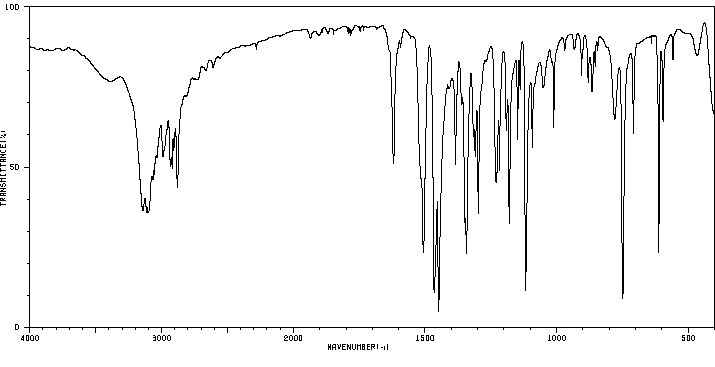1,3-二氢-2H-吲哚-2-硫酮 | 496-30-0
中文名称
1,3-二氢-2H-吲哚-2-硫酮
中文别名
2-吲哚啉硫酮;2-巯基吲哚
英文名称
indolin-2-thione
英文别名
indoline-2-thione;indole-2-thione;2-indolinethione;1,3-dihydro-2H-indole-2-thione;1,3-dihydroindole-2-thione
CAS
496-30-0
化学式
C8H7NS
mdl
MFCD00129941
分子量
149.216
InChiKey
IGJWTYFTQNHSEK-UHFFFAOYSA-N
BEILSTEIN
——
EINECS
——
-
物化性质
-
计算性质
-
ADMET
-
安全信息
-
SDS
-
制备方法与用途
-
上下游信息
-
文献信息
-
表征谱图
-
同类化合物
-
相关功能分类
-
相关结构分类
物化性质
-
沸点:243℃
-
密度:1.27
-
闪点:101℃
-
溶解度:可溶于二氯甲烷+甲醇、DMSO
计算性质
-
辛醇/水分配系数(LogP):1.8
-
重原子数:10
-
可旋转键数:0
-
环数:2.0
-
sp3杂化的碳原子比例:0.125
-
拓扑面积:44.1
-
氢给体数:1
-
氢受体数:1
安全信息
-
危险等级:IRRITANT
-
危险性防范说明:P264,P302+P352,P304+P340,P305+P351+P338,P332+P313,P337+P313
-
危险性描述:H315,H319,H335
-
储存条件:2-8°C,干燥保存。
SDS
上下游信息
反应信息
-
作为反应物:描述:参考文献:名称:Banerjee, Satarupa; Sarkar, Sandipan; Basak, Ramkrishna, Journal of the Indian Chemical Society, 2004, vol. 81, # 2, p. 169 - 170摘要:DOI:
-
作为产物:描述:参考文献:名称:吲哚硫代糖苷作为化学糖基化的有效构件。摘要:该小号吲哚基(SIN)端基异构体的部分进行了研究作为可以用于化学糖基化在多种条件,包括亲硫和金属辅助的途径被活化新的离去基团。通过扩展的机理研究了解了 SIn 部分激活的反应途径。还报道了新的 SIn 供体如何适应寡糖合成的选择性激活策略。DOI:10.1021/acs.joc.0c00943
-
作为试剂:描述:参考文献:名称:芳基氯和醇光化学有机催化合成硫醚摘要:硫醚通常存在于药物和天然化合物中,通常涉及金属交叉偶联反应、高温以及在合成过程中使用不适宜的硫醇。在这里,我们提出了一种简单的、无硫醇的有机催化方案,该方案使用温和的条件将廉价的醇和芳基氯化物缝合在一起,产生多种芳基烷基硫醚。该方法的核心是发现四甲基硫脲可以作为拦截光化学产生的芳基自由基的简单硫源。为了形成自由基,我们使用了一种现成的吲哚硫醇盐有机催化剂,当用 405 nm 光激发时,它会获得强烈的还原能力,从而能够通过单电子转移激活通常不反应的芳基氯化物。硫脲的自由基捕获,随后通过极性路径的醇攻击,导致硫醚产物的形成。DOI:10.1021/jacs.3c13900
文献信息
-
[EN] A THIONATION PROCESS AND A THIONATING AGENT<br/>[FR] PROCÉDÉ DE THIONATION ET AGENT DE THIONATION申请人:VIRONOVA AB公开号:WO2012104415A1公开(公告)日:2012-08-09A process for transforming a group >C=O (I) in a compound into a group >C=S (II) or into a tautomeric form of group (II) in a reaction giving a thionated reaction product, by use of crystalline P2S5·2 C5H5N as a thionating agent. A thionating agent which is crystalline P2S5·2 C5H5N
-
Chemoselective S-benzylation of indoline-2-thiones using benzyl alcohols作者:Mukund Jha、Oro Enaohwo、Ashley MarcellusDOI:10.1016/j.tetlet.2009.10.050日期:2009.12Indoline-2-thiones were chemoselectively S-benzylated using a variety of benzyl alcohols by boron trifluoride etherate-catalyzed reactions. The aryl substituent effect on the reactivity of the benzyl alcohols toward S-benzylation is also discussed.
-
Targeting the Binding Function 3 (BF3) Site of the Androgen Receptor Through Virtual Screening. 2. Development of 2-((2-phenoxyethyl) thio)-1<i>H</i>-benzimidazole Derivatives作者:Ravi Shashi Nayana Munuganti、Eric Leblanc、Peter Axerio-Cilies、Christophe Labriere、Kate Frewin、Kriti Singh、Mohamed D. H. Hassona、Nathan A. Lack、Huifang Li、Fuqiang Ban、Emma Tomlinson Guns、Robert Young、Paul S. Rennie、Artem CherkasovDOI:10.1021/jm3015712日期:2013.2.14The human androgen receptor (AR) is a proven therapeutic target in prostate cancer. All current antiandrogens, such as Bicalutamide, Flutamide, Nilutamide, and Enzalutamide, target the buried hydrophobic androgen binding pocket of this protein. However, effective resistance mechanisms against these therapeutics exist such as mutations occurring at the target site. To overcome these limitations, the人类雄激素受体(AR)是前列腺癌中公认的治疗靶标。当前所有的抗雄激素药,例如比卡鲁胺,氟他米特,尼鲁米特和恩杂鲁米特,都靶向该蛋白的隐埋的疏水性雄激素结合袋。然而,存在对这些治疗剂的有效抗性机制,例如在靶位点发生的突变。为了克服这些限制,AR的称为结合功能3(BF3)的表面囊被表征为小分子治疗剂的替代靶标。许多AR抑制剂直接靶向 的先前由我们(标识药物化学杂志。 2011。54,8563)。在当前的研究中,基于先前的结果,我们开发了结构-活性关系,从而可以设计一系列2-((2-苯氧基乙基)硫基)-1 H-苯并咪唑和2-((2-苯氧基乙基)硫基) -1 H-吲哚作为铅 抑制剂。一些已开发的 配体对LNCaP和耐恩杂鲁胺的前列腺癌细胞系表现出显着的抗雄激素作用。
-
(R)- and (S)-4-methylaminomethyl-2,3,4,9-tetrahydrothiopyrano[2,3-b]indole: synthesis, absolute configuration, conformation, and analgesic activity作者:Natsuki Ishizuka、Motoo Shiro、Yasuo MakisumiDOI:10.1039/p19900000827日期:——(R)- and (S)-4-Methylaminomethyl-2,3,4,9-tetrahydrothiopyrano[2,3-b] indole (2) have been synthesized and their conformation studied. (RS)-(2) Has been found to be a potent non-narcotic analgesic agent. The crucial step was regio- and stereo-specific cyclization of indolyl alkyl sulphides (S)- and (R)-(9) to both enantiomers of (10) using an intramolecular indole Grignard reaction. Optical purities
-
Au-Catalyzed Synthesis of Thiopyrano[2,3-<i>b</i>]indoles Featuring Tandem Rearrangement and Hydroarylation作者:Mukund Jha、Shiv Dhiman、T. Stanley Cameron、Dalip Kumar、Anil KumarDOI:10.1021/acs.orglett.7b00617日期:2017.4.21heteroaromatic thiopyrano[2,3-b]indole is reported using conjugated enyne tethered indole sulfides, featuring skeletal rearrangement conjoined with intramolecular hydroarylation (via C3–H functionalization of the indole core) and oxidative aromatization. Subsequent Pd-catalyzed C–C coupling resulted in a 16-π electron heteroaromatic isothiochromeno[1,8,7-bcd]indole.
表征谱图
-
氢谱1HNMR
-
质谱MS
-
碳谱13CNMR
-
红外IR
-
拉曼Raman
-
峰位数据
-
峰位匹配
-
表征信息
同类化合物
(Z)-3-[[[2,4-二甲基-3-(乙氧羰基)吡咯-5-基]亚甲基]吲哚-2--2-
(S)-(-)-5'-苄氧基苯基卡维地洛
(R)-(+)-5'-苄氧基卡维地洛
(R)-卡洛芬
(N-(Boc)-2-吲哚基)二甲基硅烷醇钠
(E)-2-氰基-3-(5-(2-辛基-7-(4-(对甲苯基)-1,2,3,3a,4,8b-六氢环戊[b]吲哚-7-基)-2H-苯并[d][1,2,3]三唑-4-基)噻吩-2-基)丙烯酸
(4aS,9bR)-6-溴-2,3,4,4a,5,9b-六氢-1H-吡啶并[4,3-B]吲哚
(3Z)-3-(1H-咪唑-5-基亚甲基)-5-甲氧基-1H-吲哚-2-酮
(3Z)-3-[[[4-(二甲基氨基)苯基]亚甲基]-1H-吲哚-2-酮
(3R)-(-)-3-(1-甲基吲哚-3-基)丁酸甲酯
(3-氯-4,5-二氢-1,2-恶唑-5-基)(1,3-二氧代-1,3-二氢-2H-异吲哚-2-基)乙酸
齐多美辛
鸭脚树叶碱
鸭脚木碱,鸡骨常山碱
鲜麦得新糖
高氯酸1,1’-二(十六烷基)-3,3,3’,3’-四甲基吲哚碳菁
马鲁司特
马鞭草(VERBENAOFFICINALIS)提取物
马来酸阿洛司琼
马来酸替加色罗
顺式-ent-他达拉非
顺式-1,3,4,4a,5,9b-六氢-2H-吡啶并[4,3-b]吲哚-2-甲酸乙酯
顺式-(+-)-3,4-二氢-8-氯-4'-甲基-4-(甲基氨基)-螺(苯并(cd)吲哚-5(1H),2'(5'H)-呋喃)-5'-酮
靛青二磺酸二钾盐
靛藍四磺酸
靛红联二甲酚
靛红磺酸钠
靛红磺酸
靛红乙烯硫代缩酮
靛红-7-甲酸甲酯
靛红-5-磺酸钠
靛红-5-磺酸
靛红-5-硫酸钠盐二水
靛红-5-甲酸甲酯
靛红
靛玉红衍生物E804
靛玉红3'-单肟5-磺酸
靛玉红-3'-单肟
靛玉红
靛噻
青色素3联己酸染料,钾盐
雷马曲班
雷莫司琼杂质13
雷莫司琼杂质12
雷莫司琼杂质
雷替尼卜定
雄甾-1,4-二烯-3,17-二酮
阿霉素的代谢产物盐酸盐
阿贝卡尔
阿西美辛杂质3







